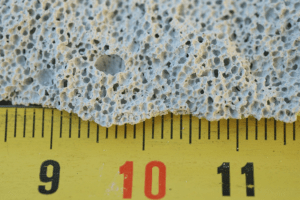BUILDING SAFETY
RAAC: How big of an issue is it?
Zoe Pond, Senior Associate, and Claire Burrows, Partner, at Brabners LLP on the long-term impact of the material.

CREDIT: Marco Bernardini-Own work, CC BY-SA 3.0,https://commons.wikimedia.org/w/index.php?curid=7915081
Reinforced Autoclaved Aerated Concrete (RAAC) has repeatedly hit the headlines in the last couple of weeks as the re-opening of at least 104 schools for the new academic year has been postponed by the Government following an inquiry that commenced in June to identify the use of RAAC across a range of public sector buildings.
Whilst the Government has come under criticism for the lateness of this decision (they’ve been aware of and monitoring public sector buildings containing RAAC, knowing it has a life span of roughly 30 years, since 1994), their assertion that “Nothing is more important than the health and safety of children and staff”, highlights the seriousness of the issue.
The Health and Executive (HSE) have placed a stark warning on their website: “RAAC is now life-expired. It is liable to collapse with little or no notice”. With the National Audit Office recently identifying more than 500 schools with buildings containing RAAC and the Department of Education reporting more than 50 schools at critical risk of sudden collapse, the full impact of remedial works to remove material, stabilise buildings or rebuild existing structures across the country is currently unknown but likely to be very significant. And the issues extend far more widely than just education settings. RAAC (a cheaper and weaker lightweight concrete material used in place of traditional concrete) was used extensively between the 1950s and 1990s in a range of public buildings including courts, hospitals and police stations.
Accordingly, the HSE have confirmed: “If you are responsible for the management, maintenance or alteration of central and local government buildings you should know whether your buildings contain RAAC, and act appropriately to ensure that such buildings are safe.”
Urgent action
By law, every owner/manager of public buildings is required to ensure the health, safety and welfare of their employees and the health and safety of those affected by their undertaking i.e.all visitors and contractors, including pupils. A failure to do so is a criminal offence that can lead to potentially unlimited fines and significant adverse PR.
Given the very real risk associated with RAAC that is now very well known, it is therefore critical that all those with responsibilities for public sector buildings take action now. Sufficient time and resource should be made available to properly determine whether RAAC is present in such buildings, its current age and condition, and any associated risks arising from the presence of RAAC (in this case, spontaneous collapse) that mandate its removal or the implementation of additional control measures to mitigate identified risks eventuating.
It is worth noting that the presence of RAAC may have a significant impact on the management of asbestos in certain buildings
As liability under health and safety legislation arises from the risk of harm, no actual harm needs to be caused for an offence to be committed meaning relevant duty holders of public sector buildings that fail to take steps to identify the presence of RAAC and conduct a thorough assessment of the potential risks to ensure such buildings are safe, are liable to face enforcement action, even if no incidents actually occur.
Asbestos and RAAC
It is worth noting that the presence of RAAC may have a significant impact on the management of asbestos in certain buildings. Before being banned, asbestos was used in various construction materials including insulation materials, pipework, guttering and boilers. For those responsible for the maintenance of non-domestic premises, including public buildings, relevant regulations include a ‘duty to manage’ any asbestos in them and to protect anyone using or working in the premises from the risks to health that exposure to asbestos causes (including mesothelioma – a type of cancer affecting the lining of the lungs).
It is well-established that if asbestos-containing materials in premises are in good condition and are unlikely to be damaged or disturbed, it is usually safer to manage them in situ as it is the smaller fibres generated when asbestos is damaged that present a risk of harm. As per the Control of Asbestos Regulations 2012, a survey should be conducted to identify the presence of asbestos, its type and condition is assessed and recorded in an asbestos register (made available to anyone likely to come into contact with it) and it is then monitored in accordance with an asbestos management plan. However, in circumstances where asbestos is likely to be disturbed or damaged or is otherwise unsafe to leave in situ, it is the duty holders’ responsibility to have it removed by a specialist contractor, which can incur high costs.
When conducting surveys to identify RAAC that is not immediately visible, it is important that any asbestos registers are consulted prior to the removal of any ceilings or finishes to ensure asbestos does not become damaged or disturbed in the process. Additionally, if the risk of spontaneous collapse arising from the presence of RAAC will have an impact on the integrity of asbestos contained in premises, asbestos may need to be removed before RAAC remediation can be undertaken to avoid further risks materialising and additional breaches of relevant legislation.
RAAC: How big of an issue is it?
Zoe Pond, Senior Associate, and Claire Burrows, Partner, at Brabners LLP on the long-term impact of RAAC.
Safety & Health Practitioner
SHP - Health and Safety News, Legislation, PPE, CPD and Resources Related Topics
Housing company fined more than £500k after worker suffers burns
Company fined as worker has leg amputated
Aviation company fined after worker death at Heathrow Airport

